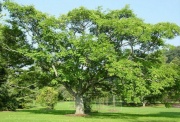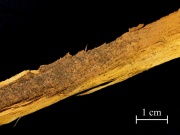Difference between revisions of "Amur cork tree"
Jump to navigation
Jump to search
(username removed) |
|||
| (4 intermediate revisions by 3 users not shown) | |||
| Line 1: | Line 1: | ||
[[File:image 2-Amur cork tree.jpg|thumb|Amur cork tree]] | [[File:image 2-Amur cork tree.jpg|thumb|Amur cork tree]] | ||
== Description == | == Description == | ||
| − | + | [[File:Amur_cork_tree_bark_kihada.jpg|thumb|Amur cork tree (''Philodendron amurens'')]] | |
| − | The bark from the amur cork tree (''Phellodendron amurense'') is extracted to produce a yellow dye. The principal colorant is [ | + | The bark from the amur cork tree (''Phellodendron amurense'') is extracted to produce a yellow dye. The principal colorant is [[berberine sulfate|berberine]]. |
== Synonyms and Related Terms == | == Synonyms and Related Terms == | ||
| Line 8: | Line 8: | ||
''Phellodendron amurense''; kihada (Jap.); Japanese yellow wood | ''Phellodendron amurense''; kihada (Jap.); Japanese yellow wood | ||
| − | + | == Physical and Chemical Properties == | |
| − | |||
| − | |||
| − | == | ||
Autofluorescence = intense yellow | Autofluorescence = intense yellow | ||
| − | |||
| − | |||
| − | |||
| − | |||
== Additional Images == | == Additional Images == | ||
| Line 27: | Line 20: | ||
</gallery> | </gallery> | ||
| + | ==Resources and Citations== | ||
| + | * S.Simoyama, Y.Noda, S.Katshuhara, "Non-Destructive Analysis of Ukiyo-E Prints" ''Dyes in History and Archaeology'', No.15, Paper presented in Manchester England, Nov. 1996. | ||
| − | + | * ''Encyclopedia Britannica'', http://www.britannica.com Comment: cork tree" a [Accessed March 5, 2002]. | |
| − | |||
| − | * ''Encyclopedia Britannica'', http://www.britannica.com Comment: cork tree" | ||
| − | * | + | * R.Feller, M.Curran, C.Bailie, 'Identification of Traditional Organic Colorants Employed in Japanese Prints and Determination of their Rates of Fading', ''Japanese Woodblock Prints'', Allen Memorial Art Museum, Oberlin College, Oberlin, 1984 |
[[Category:Materials database]] | [[Category:Materials database]] | ||
Latest revision as of 13:46, 26 April 2022
Description
The bark from the amur cork tree (Phellodendron amurense) is extracted to produce a yellow dye. The principal colorant is berberine.
Synonyms and Related Terms
Phellodendron amurense; kihada (Jap.); Japanese yellow wood
Physical and Chemical Properties
Autofluorescence = intense yellow
Additional Images
Resources and Citations
- S.Simoyama, Y.Noda, S.Katshuhara, "Non-Destructive Analysis of Ukiyo-E Prints" Dyes in History and Archaeology, No.15, Paper presented in Manchester England, Nov. 1996.
- Encyclopedia Britannica, http://www.britannica.com Comment: cork tree" a [Accessed March 5, 2002].
- R.Feller, M.Curran, C.Bailie, 'Identification of Traditional Organic Colorants Employed in Japanese Prints and Determination of their Rates of Fading', Japanese Woodblock Prints, Allen Memorial Art Museum, Oberlin College, Oberlin, 1984




